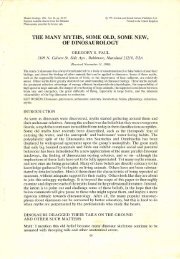HUNTERIA - Gregory S. Paul
HUNTERIA - Gregory S. Paul
HUNTERIA - Gregory S. Paul
Create successful ePaper yourself
Turn your PDF publications into a flip-book with our unique Google optimized e-Paper software.
Russell, D., Beland, P. and McIntosh, ].S. 1980. Paleoecology<br />
of the dinosaurs ofTendaguru (Tanzania). Memoirs Societe<br />
Geologie Francais 59 (139):169-175.<br />
Spinar, Z.v. and Burian, Z. 1972. Life Before Man. New<br />
York: American Heritage Press.<br />
Stokes, W.L. 1985. The Cleveland-Lloyd Dinosaur Quarry,<br />
window to the past. U.S. Government Printing Office<br />
1-27.<br />
The neck of B. (G.) brancai HMN JII is about 0.3 m<br />
shorter than the 9.3 m neck of the primitive, 9 ton diplodocid<br />
Mamenchisaurus hochuanensis PMNH 3 (Young and<br />
Chow, 1972). It is likely that Supersaurus also had a longer<br />
neck than the largest Brachiosaurus.<br />
Martin (1987) restores the neck of the sauropod<br />
Cetiosaurus as barely able to reach the ground, rise above<br />
the height of the shoulders, or swing to either side. That such<br />
a neck of 14 bird-like vertebrae would be far less flexible than<br />
the giraffe's neck of 7 vertebrae is untenable. A high number<br />
of vertebrae directly implies great flexibility, since a stiff long<br />
neck is better achieved by lengthening a few vertebrae, as in<br />
the giraffe. Errors in Martin's restoration include a maximum<br />
raised neck posture that is really its normal, neutral S curve,<br />
zygapophyses that are virtually immobile, and an average of<br />
only 1.4° of motion from the centerline between each cervical.<br />
Instead, the sauropod cervical combination of ball and socket<br />
centra articulations with large zygapophyses was designed to<br />
maintain articulation over a much greater range of motion<br />
than Martin shows, especially when the bony joint areas were<br />
expanded by cartilagenous surfaces. Exactly how much more<br />
I am not sure, what one can learn from dry bone manipulations<br />
or paper studies is useful, but not necessarily true to life.<br />
Sauropod and giraffe cervicals are remarkably similar; study<br />
of the latter might prove helpful to the problem. Note that<br />
a modest 12° or so of rotation between successive segments<br />
in 6 posterior cervicals would allow the sauropod head to reach<br />
GREGORY S. PAUL<br />
NOTES ADDED IN PROOF<br />
Van Valen, L. 1969. What was the largest dinosaur? Copeia<br />
1969:624-262<br />
Watson, ].W. and ZaUinger, R.F. 1960. Dinosaurs and Other<br />
Prehistoric Reptiles. New York: Golden Press.<br />
. high up. This mobility is plausible since many mammals can<br />
do the same with only 7 cervicals. The extreme neck<br />
inflexibility Martin restores in sauropods is also functionally<br />
illogical, since shorter necked ungulates can reach as far up<br />
and to the side relative to their size. Long necks are an extreme<br />
adaptation, and among land herbivores their only useful<br />
purpose is to increase the vertical reach of high browsers. Low<br />
browsers and grazers invariably have modest necks because<br />
they can always reach what they want by just taking a few<br />
steps towards it.<br />
Contrary to Martin (1987), the ilial pubic penducles of all<br />
sauropods were massive, buttressed from the front and inside<br />
by stout sacral ribs, and well able to bear the mass of a rearing<br />
individual. Note that sauropods only stood, or occasionally<br />
slowly walked, bipedally. They did not incur the stresses of<br />
fast bipedal motion.<br />
PMNH - Beijing Museum of Natural History, Beijing.<br />
Martin, ]. 1987. Mobility and feeding of Cetiosaurus<br />
(Saurischia, Sauropoda) - why the long neck? In: Currie,<br />
P.]. and Koster, E.H. (eds.). Fourth Symposium on<br />
Mesozoic Terrestrial Ecosystems. Drumheller: Tyrell<br />
Museum of Paleontology. pp. 150-155.<br />
Young c.c. and Chow X.]. 1972. On Mamenchisaurus<br />
hochuanensis. Paleontographica Sinica, A., Special Issue<br />
8:1-30<br />
Total cost of production of this paper was donated by Dinamation International, Chris Mays, President.<br />
<strong>HUNTERIA</strong> VOL. II, no. 3, pp. 14, February 19, 1988<br />
-- _









